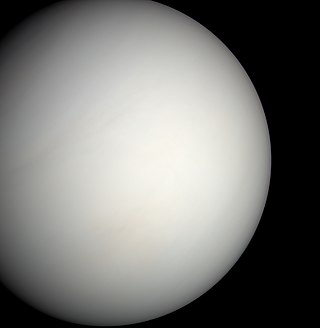
Venus is the second planet from the Sun. It is a rocky planet with the densest atmosphere of all the rocky bodies in the Solar System, and the only one with a mass and size that is close to that of its orbital neighbour Earth. Orbiting inferiorly, it appears in Earth's sky always close to the Sun, as either a "morning star" or an "evening star". While this is also true for Mercury, Venus appears much more prominently, since it is the third brightest object in Earth's sky after the Moon and the Sun, appearing brighter than any other star-like classical planet or any fixed star. With such prominence in Earth's sky, Venus has historically been a common and important object for humans, in both their cultures and astronomy.

A lullaby, or a cradle song, is a soothing song or piece of music that is usually played for children. The purposes of lullabies vary. In some societies they are used to pass down cultural knowledge or tradition. In addition, lullabies are often used for the developing of communication skills, indication of emotional intent, maintenance of infants' undivided attention, modulation of infants' arousal, and regulation of behavior. Perhaps one of the most important uses of lullabies is as a sleep aid for infants. As a result, the music is often simple and repetitive. Lullabies can be found in many countries, and have existed since ancient times.

Marvin the Paranoid Android is a fictional character in The Hitchhiker's Guide to the Galaxy series by Douglas Adams. Marvin is the ship's robot aboard the starship Heart of Gold. Originally built as one of many failed prototypes of Sirius Cybernetics Corporation's GPP technology, Marvin is afflicted with severe depression and boredom, in part because he has a "brain the size of a planet" which he is seldom, if ever, given the chance to use. Instead, the crew request him merely to carry out mundane jobs such as "opening the door". Indeed, the true horror of Marvin's existence is that no task he could be given would occupy even the tiniest fraction of his vast intellect. Marvin claims he is 50,000 times more intelligent than a human, though this is, if anything, an underestimation. When kidnapped by the bellicose Krikkit robots and tied to the interfaces of their intelligent war computer, Marvin simultaneously manages to plan the entire planet's military strategy, solve "all of the major mathematical, physical, chemical, biological, sociological, philosophical, etymological, meteorological and psychological problems of the Universe, except his own, three times over", and compose a number of lullabies.

Ian Chesterton is a fictional character in the British science fiction television series Doctor Who and a companion of the First Doctor. He was played in the series by William Russell, and was one of the members of the programme's first regular cast, appearing in the bulk of the first two seasons from 1963 to 1965. In a film adaptation of one of the serials, Dr. Who and the Daleks (1965), he was played by Roy Castle, but with a very different personality and backstory. Ian appeared in 16 stories and 77 episodes.
The Curse of Peladon is the second serial of the ninth season of the British science fiction television series Doctor Who, which was first broadcast in four weekly parts on BBC1 from 29 January to 19 February 1972.

Melanie "Mel" Bush is a fictional character played by Bonnie Langford in the long-running British science fiction television series Doctor Who. A computer programmer from the 20th century who is a companion of the Sixth and Seventh Doctors, she was a regular in the programme from 1986 to 1987. Mel appeared in six stories, and is the penultimate companion of the classic series.
"Ar Hyd y Nos" is a Welsh song sung to a tune that was first recorded in Edward Jones' Musical and Poetical Relics of the Welsh Bards (1784). The most commonly sung Welsh lyrics were written by John Ceiriog Hughes (1832-1887), and have been translated into several languages, including English and Breton. One of the earliest English versions, to different Welsh lyrics by one John Jones, was by Thomas Oliphant in 1862.

The Ice Warriors are a fictional extraterrestrial race of reptilian humanoids in the long-running British science fiction television series Doctor Who. They were originally created by Brian Hayles, first appearing in the 1967 serial The Ice Warriors where they encountered the Second Doctor and his companions Jamie and Victoria. In Doctor Who, the Ice Warriors originated on Mars, which within the series narrative is a dying world. Their early appearances depict the Ice Warriors as attempting to conquer the Earth and escape their planet as early as Earth's Ice Age. A frozen group are discovered by an Earth scientific team who dub them 'Ice Warriors' in their first appearance. Despite this not being the name of their species, an Ice Lord later refers to his soldiers as Ice Warriors in the 1974 serial The Monster of Peladon. Similarly there is a fleeting reference to themselves as such in The Curse of Peladon. Although originally appearing as villains, subsequent appearances have depicted Ice Warriors that have eschewed violence and even ally themselves with the Doctor. They have also been featured in flashback and cameo appearances, in addition to appearing frequently in spin-off media such as novels and audio releases.

The planet Venus has been used as a setting in fiction since before the 19th century. Its impenetrable cloud cover gave science fiction writers free rein to speculate on conditions at its surface—a "cosmic Rorschach test", in the words of science fiction author Stephen L. Gillett. The planet was often depicted as warmer than Earth but still habitable by humans. Depictions of Venus as a lush, verdant paradise, an oceanic planet, or fetid swampland, often inhabited by dinosaur-like beasts or other monsters, became common in early pulp science fiction, particularly between the 1930s and 1950s. Some other stories portrayed it as a desert, or invented more exotic settings. The absence of a common vision resulted in Venus not developing a coherent fictional mythology, in contrast to the image of Mars in fiction.

Queen of Outer Space is a 1958 American science fiction feature film shot in DeLuxe Color and CinemaScope. Produced by Ben Schwalb and directed by Edward Bernds, it stars Zsa Zsa Gabor, Eric Fleming, and Laurie Mitchell. The screenplay by Charles Beaumont, about a revolt against a cruel Venusian queen, is based on an idea supplied by Ben Hecht and originally titled Queen of the Universe. Upon its release, the film was promoted by Allied Artists and distributed to some locations as a double feature with Frankenstein 1970 starring Boris Karloff

The Paradise of Death is a 5-part BBC radio drama, based on the long-running British science fiction television series Doctor Who, and starring Jon Pertwee as the Doctor.

Pirates of Venus is a science fantasy novel by American writer Edgar Rice Burroughs, the first book in the Venus series, the last major series in Burroughs's career. It was first serialized in six parts in Argosy in 1932 and published in book form two years later by Edgar Rice Burroughs, Inc. The events occur on a fictionalized version of the planet Venus, known as "Amtor" to its inhabitants.
Paul J. Leonard Hinder, better known by his pseudonym of Paul Leonard and also originally published as PJL Hinder, is an author best known for his work on various spin-off fiction based on the long-running British science fiction television series Doctor Who.

The Price of Paradise is a BBC Books original novel written by Colin Brake and based on the long running science fiction television series Doctor Who. It was published on 21 September 2006 alongside The Nightmare of Black Island and The Art of Destruction. It features the Tenth Doctor and Rose.

The Bride of Peladon is a Big Finish Productions audio drama based on the long-running British science fiction television series Doctor Who.

"Music of the Spheres" is an interactive mini-episode of the British science fiction television series Doctor Who that premiered at the Royal Albert Hall in London before the Intermission of the Doctor Who Prom on 27 July 2008, for which it was especially made. The Doctor Who Prom, including the audio for "Music of the Spheres", was broadcast simultaneously on BBC Radio 3. "Music of the Spheres" was shown on the official BBC Doctor Who website during the interval and the concert itself was filmed for later broadcast on BBC One on 1 January 2009.
Target Luna was a British television serial broadcast by ABC Weekend TV in April 1960. It was written by Malcolm Hulke and Eric Paice, directed by Adrian Brown and produced by Sydney Newman who later co-created Doctor Who for the BBC. The first serial featured Frank Finlay as Conway Henderson and Michael Craze as Geoffrey Wedgwood. The success of the Target Luna spawned three sequels: Pathfinders in Space, Pathfinders to Mars and Pathfinders to Venus, starring Gerald Flood and Stewart Guidotti in the recast roles, as Henderson and Geoffrey respectively.













